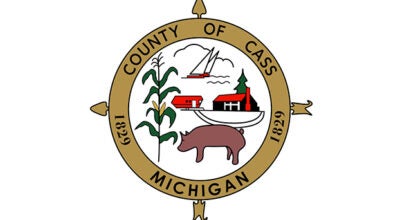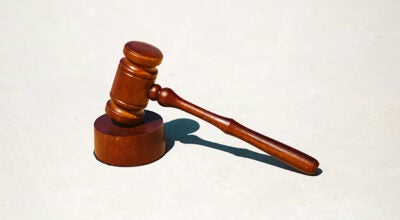Vandalia landmark lost
Published 8:03 pm Thursday, November 8, 2012
VANDALIA — Like Dowagiac’s Beckwith Theatre, Vandalia F&AM Lodge 290 is one that got away.
The pile of brick rubble at 17932 Mill St. was the original Quaker meeting house built in 1879.
The Masons were chartered by the Grand Lodge of Michigan on Jan. 12, 1871. The lodge celebrated its centennial with Marcellus Lodge 291 on April 21, 1971.
Warren Anglemyer was Vandalia’s 1971 worshipful master. Amos Smith was the first in 1871. The organizational meeting of Nov. 5, 1870, took place in a room over the J.W. Curtis Drug Store.
On Jan. 5, 1888, a fire destroyed the building where the lodge met, destroying records and furniture. The Masons received permission from the Grand Lodge to meet at Fairbanks Hall.
The Underground Railroad Society of Cass County’s mission is to preserve and restore the James E. Bonine house and carriage house on M-60 as outstanding examples of Victorian domestic architecture; create a museum, learning center and community meeting house as the focal point for understanding the role Quaker, African-American and other abolitionist groups played in the Underground Railroad; and create a cultural tourism destination for Underground Railroad enthusiasts to entice visitors and tourism dollars into the community.
That’s why Cathy LaPointe of the Underground Railroad Society is “heartbroken” this “cornerstone of Vandalia” with the collapsed roof was demolished rather than rescued.
“It’s a shame this iconic structure was left to ruin,” she said Tuesday.
Past Master Ralph E. Waterman, a Mason since 1995, hoped to salvage the stone sign, but it lay on the ground in pieces to his dismay on Wednesday.
Waterman researched the history for a May 3, 2010, presentation of a commissioned painting which hangs in the Vandalia lodge’s Union home. Masons vacated the church more than 40 years ago when it became infested with bees.
Sept. 17, 1917, Masons started negotiations to purchase the building. The lodge met at the former Quaker meeting house until its 100th anniversary, when it was decided by a 24-0 vote to shift the temple to Union. According to lodge minutes, the move to Union was first discussed Oct. 4, 1971.
The first meeting in the new building in Union was called to order by Worshipful Master James Russell on Sept. 9, 1974.
Vandalia thrived
According to “A Brief History of Cass County,” compiled by Mae R. Schoetzow in 1935, Stephen Bogue — James E. Bonine’s father-in-law — and C.P. Ball laid out the village of Vandalia and built a more modern grist mill.
The county’s first grist mill was built south of Vandalia in 1828 — “a very primitive affair, but it met the needs of the pioneers at that time.”
Asa Kingsbury, an early Cassopolis merchant, opened Vandalia’s first store, managed by agents. Dr. A.L. Thorp was the first physician.
Bustling Vandalia in 1875 had two dry goods stores, one clothing store, a hardware store, three grocery stores, a boot and shoe store, two drug stores, two meat markets, one machine shop, a foundry with planing mill attached, four blacksmith shops, one furniture and cabinet shop, a wagon shop, two hotels, a millinery shop, a handle factory with a sawmill and planing mill combined, a broom factory, a cooper shop, a tin shop, a livery barn, three physicians and three churches.
The meeting house and the Bonine house resembled each other.
The Bonine house was built with brick kilned on Lot Bonine’s property. The tower is the same Second Empire style as the Bonine House. They likely shared the same architect.
Bogue and James E. Bonine belonged to Youngs Prairie Anti-Slavery Society and were prominent members of the Underground Railroad operated from 1840 to 1860.
Bogue and Bonine built the meeting house so Quakers in Vandalia wouldn’t have to travel to Prairie Grove meeting in Penn (now Penn Friends).
LaPointe believes Quakers divided over how to respond to slavery around 1843. Birch Lake Quakers (the original meeting) didn’t approve, but didn’t want to break the law to join the UGRR.
Bogue, Bonine, Osborn, Shugart, Lee and Jones formed Youngs Prairie Anti-Slavery Society (the only Quaker Anti-Slavery Society in Michigan) and were active in UGRR.
Around 1850, the two factions reunited and all were involved in the UGRR after that.
“But the Youngs Prairie group never joined Prairie Grove/Penn Friends — although they helped plan the original Penn Friends church,” LaPointe said, “so, in my opinion, there was still some division in the Quaker community and the Youngs Prairie group wanted their own church. James E. Bonine’s father, Isaac, founded Prairie Grove that became Penn Friends and, to my knowledge, James E. never joined his father’s church.”
The 60 members of the Vandalia Masonic lodge meet on the first Monday at 7 p.m. at 15598 U.S. 12, according to Secretary Kerry Bathe.
After the structure lost its exempt status and Penn Township returned it to the tax roll, it was acquired after three years by the Cass County Land Bank and torn down.







